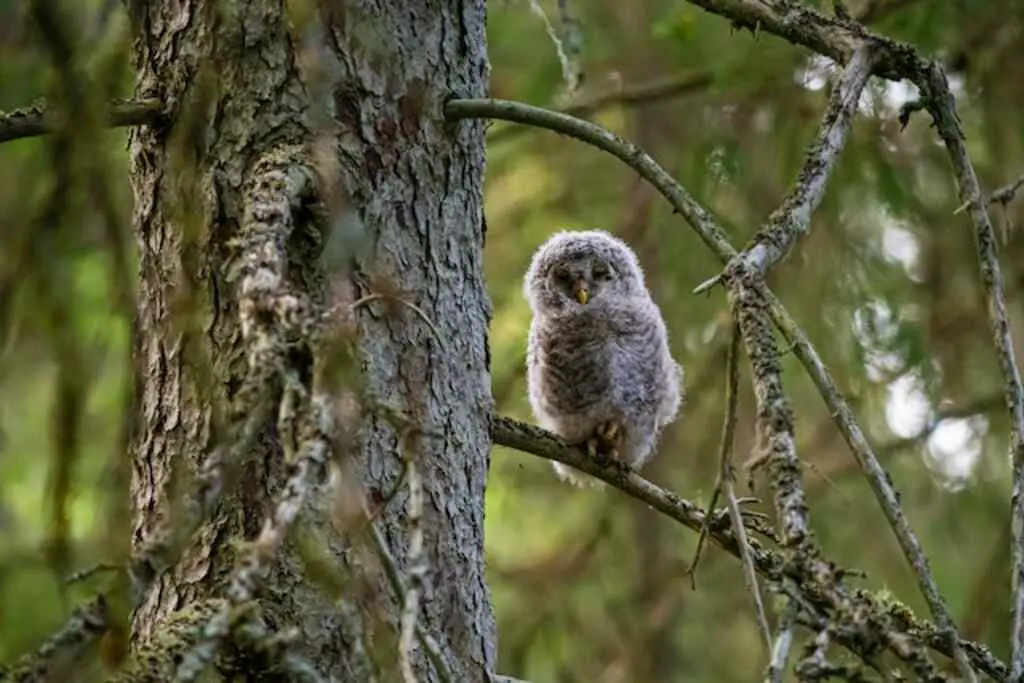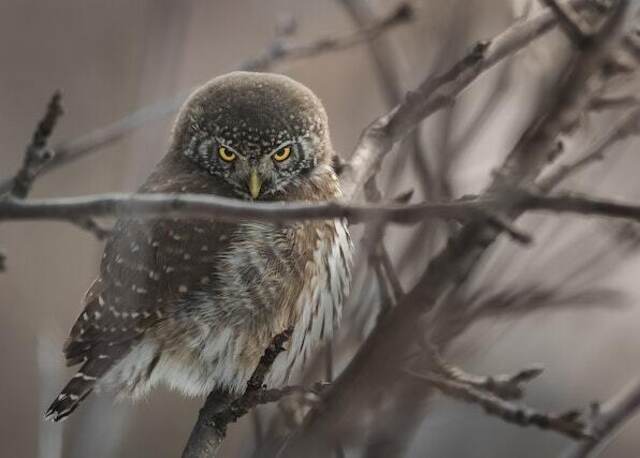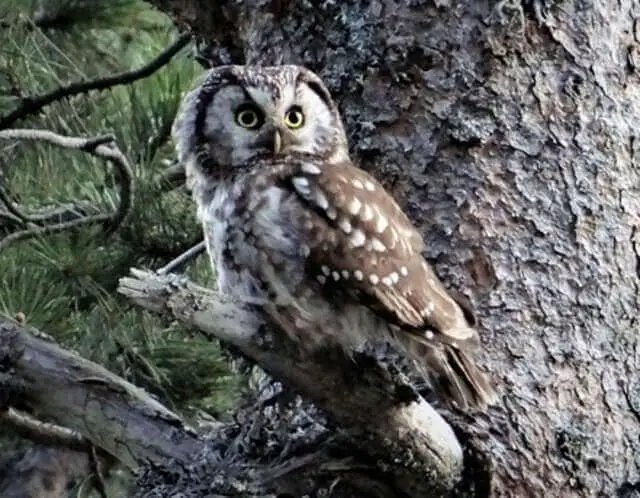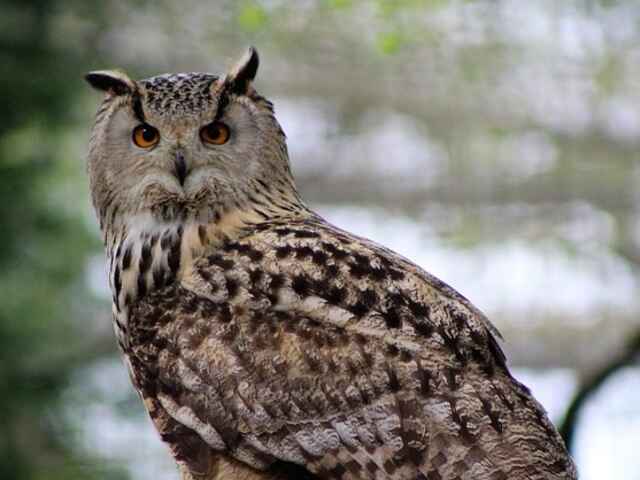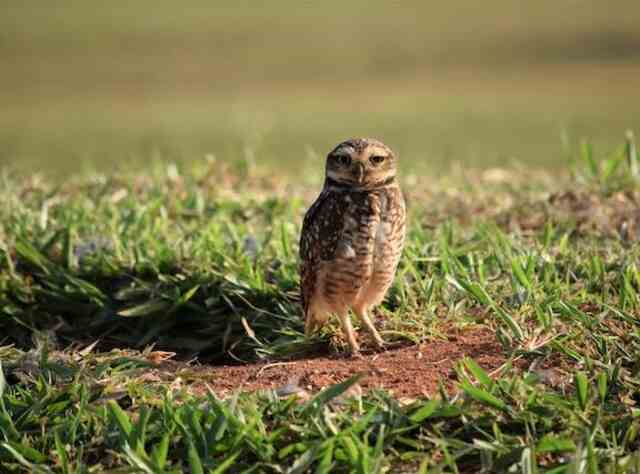How Do Owls Sleep? Do they doze off with their eyes closed like we do? Or do they stay alert all night, ready to pounce on their prey? Well, the short answer is: it’s complicated.
Owls have a unique sleep pattern that’s unlike anything you’ve ever seen before. But don’t worry, we’ve got all the details. So, if you’re curious about the mysterious world of owls and their bizarre sleeping habits, keep reading!
Table of Contents
- 1 The Nocturnal Majesty of Owls
- 2 A Brief Overview of Owls
- 3 The Importance of Sleep for Animals
- 4 Owl Sleep Habits
- 5 Sleeping Positions and Locations
- 6 Length and Timing of Owl Sleep Cycles
- 7 The Science Behind Owl Sleep
- 8 Owl Sleep Myths Debunked
- 9 Summary of Key Points Discussed in the Article
- 10 Impact of Understanding Owl’s Sleeping Habits on Conservation Efforts
- 11 Final Thoughts
- 12 Author
The Nocturnal Majesty of Owls
Owls are fascinating creatures that have captured the imagination of humans for generations. These nocturnal birds of prey have a reputation for being wise, mysterious, and elusive, and their unique sleeping habits only add to their mystique.
Owls are known for being able to sleep while perched in trees or while hanging upside down from branches – behaviors that seem unnatural and even uncomfortable to us as humans.
But how do owls sleep, and why do they do it in such unusual positions? In this article, we’ll explore the sleeping habits of owls and try to shed some light on these intriguing questions.
A Brief Overview of Owls
Before delving into owl sleep habits specifically, it’s important to understand some basic facts about these birds. Owls belong to the order Strigiformes, which includes over 200 species worldwide. They range in size from tiny elf owls that weigh just a few ounces to large eagle owls that can weigh over 10 pounds.
Most owl species are nocturnal, meaning they are active at night and rest during the day. Their eyesight is well adapted for low-light conditions, with large eyes that allow them to see in almost complete darkness.
The Importance of Sleep for Animals
Sleep is an essential part of life for all animals, including birds like owls. During sleep, animals undergo crucial physiological processes such as memory consolidation, tissue repair and regeneration, and immune system maintenance.
Sleep deprivation can result in a wide range of negative effects on animal health and behavior including impaired cognitive function, weakened immune response, increased stress levels, decreased survival rates in dangerous environments or habitats facing stressors like extreme weather patterns or predators.
though owls may not be our typical idea of an animal that sleeps, it is important to understand their sleep habits and how it contributes to their health and survival in the wild.
In the following sections, we will explore the unique ways in which owls sleep, including their sleeping positions and locations as well as the length and timing of their sleep cycles.
Owl Sleep Habits
The Nocturnal Nature of Owls
Owls are known for being nocturnal animals, which means they are most active during the night. This is because their eyes are adapted to low light conditions, and they have excellent night vision.
Their nocturnal nature also allows them to avoid predators that may be more active during the day. When the sun goes down, owls typically leave their roosts or nesting sites to hunt for prey such as rodents, small mammals and insects.
They use their keen sense of hearing to locate prey and then swoop in silently to catch it with their sharp talons. Once they have caught their meal, they return to their roost or nest site, where they will rest until it’s time to hunt again.
Unique Sleeping Positions and Locations
Owls have some unique sleeping positions and locations that differ from other birds. Because of their talons and hooked beaks, owls can perch on branches or in tree hollows while asleep without falling off. They also have the ability to sleep on the ground or in burrows if necessary.
One interesting fact about owl sleeping habits is that some species can sleep while hanging upside down from branches!
This occurs because many owl species have flexible necks that allow them to rotate their heads 270 degrees or more – a useful adaptation for hunting prey – but this also allows them to hang upside down comfortably.
Here’s a table showcasing some of the unique sleeping positions and locations of different owl species:
| Owl Species | Unique Sleeping Position | Location |
|---|---|---|
| Burrowing Owl | Sleeping face down | In a burrow dug into the ground |
| Snowy Owl | Sleeping on one foot | On the ground, on a mound or rock outcrop |
| Barn Owl | Sleeping upside down | In tree hollows, caves, or old buildings |
| Long-eared Owl | Sleeping in a hunched position | In dense foliage, like evergreen trees |
| Northern Pygmy Owl | Sleeping in a tree cavity | In trees with natural holes or woodpecker cavities |
| Elf Owl | Sleeping in a vertical position | In tree cavities or saguaro cacti |
Note that these are just a few examples of the unique sleeping habits of different owl species.
Length and Timing of Owl Sleep Cycles
Like humans, owls have both rapid eye movement (REM) sleep cycles and non-REM cycles when they sleep. However, the duration of these cycles varies depending on the owl species as well as environmental factors such as temperature and available food sources.
In general, adult owls tend to require less sleep than juvenile owls due to differences in their activity levels and energy needs. Some owl species have been observed sleeping in short periods throughout the day rather than having one long stretch of sleep at night.
Overall, understanding the sleep habits of owls is important for their conservation and management. Knowing what habitats they use for sleeping, how long they need to rest, and when they are most active can help us protect these fascinating creatures in the wild.
Here’s a table for the length and timing of owl sleep cycles:
| Owl Species | Total Sleep Time | Sleep Cycle Length | Sleep Cycle Timing |
|---|---|---|---|
| Barn Owl | 9-10 hours | 70 minutes | Daytime or nighttime |
| Snowy Owl | 6 hours | 4-5 hours | Daytime |
| Great Horned Owl | 12 hours | 120 minutes | Nighttime |
| Eastern Screech Owl | 9-10 hours | 30-40 minutes | Nighttime |
Note: Sleep cycle timing may vary based on factors such as environmental conditions and food availability. These figures are meant to provide general information on owl sleep patterns.
Sleeping Positions and Locations
Owls are known to adapt to their environment when choosing a sleeping position and location. They have been observed sleeping in various positions, including perching on branches or in tree hollows, sleeping on the ground or in burrows, and even hanging upside down from branches.
Perching on Branches or in Tree Hollows
Perching high up on branches is a common sleeping position for owls. Owls have adapted to this position by having one leg bent while the other is kept straight. The bent leg allows them to stay secured onto the branch while they sleep.
They also use their sharp talons to grip onto the branch, providing further stability while they rest. Tree hollows are another popular spot for owls to sleep.
These spots provide an excellent hiding place from predators and harsh weather conditions. Owls may use these hollows for nesting as well as sleeping.
Sleeping on the Ground or in Burrows
Some species of owls prefer to sleep on the ground or in burrows. Burrowing owls can dig their own burrows or take over abandoned burrows of other animals such as prairie dogs or ground squirrels. These burrows provide shelter from predators and harsh weather conditions.
Owls that sleep on the ground may do so due to a lack of elevated spots like trees, or because it is easier for them to hunt prey from this position. However, this can make them vulnerable to attacks by larger predators like coyotes or foxes.
Hanging Upside Down from Branches
The barn owl is known for sleeping upside down from tree branches, with its head lowered between its legs. This unique behavior allows them to conserve body heat by keeping their feathers close to their bodies, while also providing a safe and hidden sleeping location.
While it may seem uncomfortable to sleep in such a position, owls have adapted to it over time. The unique structure of their neck bones allows them to rotate their head up to 270 degrees, providing greater flexibility when choosing a sleeping position.
Overall, owls have evolved to adapt and thrive in various environments. Their unique sleeping positions and locations provide them with safety, shelter and comfort while they rest.
Length and Timing of Owl Sleep Cycles
Owls are known for their peculiar sleep habits. These fascinating creatures have a unique pattern of sleep cycles that is different from most other animals. Typically, owls will spend much of the day in a state of rest, with only brief periods of activity.
At night, however, owls become active and hunt for prey. The length and timing of owl sleep cycles are influenced by the environment and age.
Differences between adult and juvenile owl sleep patterns
Young owls require more sleep than adults due to their increased energy expenditure through growth and development. As they mature, they gradually reduce their sleeping hours but maintain the same pattern as an adult owl.
Adult owls tend to have shorter periods of deep sleep (REM) as compared to non-REM (NREM) phases. On average, an adult owl sleeps for around six hours per day.
here’s a table outlining some differences between adult and juvenile owl sleep patterns:
| Sleep Pattern | Adult Owls | Juvenile Owls |
|---|---|---|
| Sleep Duration | 6-8 hours per day | Up to 20 hours per day |
| Sleep Position | Mostly upright | Lying down |
| REM Sleep | More frequent | Less frequent |
| Sleep Depth | Deeper, more restful sleep | Lighter sleep, easier to wake up |
| Sleep Location | Mostly in trees or perched on branches | On the ground or in nest boxes |
| Sleep Schedule | No set schedule, sleep throughout day and night | More regular sleep patterns, sleep at night and nap during day |
Note: These differences are generalizations and may vary between different species of owls.
How environmental factors affect owl sleep patterns
The sleeping habits of an owl can be significantly influenced by environmental factors such as temperature, light intensity, humidity levels, moon phases among others.
Many species prefer to rest during the daytime in shaded locations away from direct sunlight or heat sources; this allows them to conserve energy while avoiding dehydration or overheating risks. Owl’s circadian rhythms are also affected by lunar cycles- a phenomenon called ‘circalunar rhythm’.
For example, on nights near the full moon phase where moonlight is bright enough to provide illumination for hunting; an owl may reduce its sleeping duration as they take advantage of better visibility.
Understanding how environmental factors impact an owl’s sleeping patterns can help conservation efforts aimed at protecting these fascinating creatures in the wild; it also provides valuable insights into how animals adapt their behavior to changing environments over time.
Here’s a table that highlights the environmental factors that affect owl sleep patterns:
| Environmental Factor | Effect on Owl Sleep Patterns |
|---|---|
| Light | Regulates circadian rhythm |
| Noise | Disrupts sleep and affects alertness |
| Temperature | Affects metabolic rate and can alter sleep duration |
| Predators | Disrupts sleep and can trigger stress response |
Please note that this table is not comprehensive and there may be additional environmental factors that affect owl sleep patterns.
The Science Behind Owl Sleep
Brain activity during REM and non-REM sleep cycles
Owls, like other animals, experience different stages of sleep. The two main stages are rapid eye movement (REM) sleep and non-rapid eye movement (NREM) sleep. During REM sleep, the brain is highly active while the body is completely relaxed.
This is when most dreaming occurs. In contrast, during NREM sleep, the brain is less active and the body may move around more.
Research has shown that owls spend more time in NREM sleep than in REM sleep. During NREM sleep, owls show decreased muscle activity and slow eye movements.
However, during REM sleep they show an increase in muscle activity and rapid eye movements. It’s believed that these differences in brain activity patterns between NREM and REM may be related to different physiological functions.
| Sleep Stage | Brain Activity of Owls |
|---|---|
| REM Sleep | Similar brain activity to when they are awake, with rapid eye movements and muscle paralysis |
| Non-REM Sleep | Slower brain activity, decreased muscle tone, and occasional eye movements |
How owls’ unique physiology affects their sleep habits
Owls have several unique physiological features that affect their sleeping habits. One of these features is their large eyes relative to their head size.
This allows them to see well in low light conditions but also means that they have less room for muscles controlling eye movement. During NREM sleep, our eyes move around as we experience dreams or images from our subconsciousness.
However, this isn’t possible for owls due to their lack of space for these muscles around their eyes. Instead, studies suggest that owls process visual information through a type of “virtual reality” mechanism in their brains while they are asleep.
Another unique feature of owl physiology is that they have a relatively small diaphragm compared to other birds, which means they can’t puff up or expand like other birds do when asleep. This could explain why many species of owl adopt a hunched posture while sleeping, since it may help with breathing.
Understanding the science behind owl sleep can provide crucial insight into the physiology and behavior of these fascinating birds. By studying their sleep habits, we can learn more about how they function in their natural habitats and how we can better protect them.
| Unique Physiology | How it Affects Sleep Habits |
|---|---|
| Large Eyes | Owls have excellent night vision and can hunt in the dark, but their large eyes also make them more sensitive to light and require them to sleep during the day |
| Rotatable Head | Owls can rotate their head up to 270 degrees, allowing them to see prey from different angles. However, this also means they must keep their head in a fixed position while sleeping |
| Asymmetric Ears | Owls’ ears are asymmetrical and placed at different heights on their head, allowing them to locate prey through sound. This means they sleep with one ear facing down and the other facing up to maintain their auditory awareness |
| Nocturnal Activity | Owls are most active at night and may sleep during the day. This is because their eyes are adapted to low-light conditions, and their prey is also active at night. |
Owl Sleep Myths Debunked
Owls don’t always sleep at night.
It’s a common misconception that owls only sleep during the day since they are nocturnal animals. However, owls do not sleep exclusively during the day or night. In fact, some owls are active during the day while others are active at night.
Moreover, not all owls follow a strict nocturnal schedule. For instance, some owl species in high latitudes where daylight lasts for several months have been known to be active even during the daytime.
Furthermore, owls can adjust their sleeping patterns based on environmental factors such as food availability and breeding season. During breeding season, for example, some owl species may become more active during the day to hunt and forage for food to feed their young ones.
Owls can’t rotate their heads 360 degrees while sleeping.
It’s true that owls have extraordinary neck flexibility that allows them to rotate their heads up to 270 degrees without causing any harm or discomfort to their spine or nervous system. However, contrary to popular belief, owls cannot rotate their heads 360 degrees in any direction.
The reason why an owl’s head rotation is limited is due to its unique skeletal structure and anatomy. Owls have fourteen cervical vertebrae compared to seven cervical vertebrae found in humans, which give them greater neck mobility.
Moreover, specialized blood vessels in an owl’s neck region help prevent blood flow interruption when they turn their head around.
While it may seem like a small detail; it’s important for people who have an interest in these magnificent creatures’ habits and behavior patterns-especially when studying them as part of conservation efforts-to know the facts about how these birds rest and move.
Owls are remarkable birds with unique abilities adapted to their nocturnal lifestyle. They have several distinctive sleeping habits that are critical to their survival and play an essential role in regulating their bodily functions.
While there are many misconceptions about owls’ sleeping habits, it’s important to separate fact from fiction when studying these majestic creatures.
By better understanding the science behind owl sleep patterns, we can learn more about these fascinating birds and develop effective conservation strategies that take into account their unique behavior and environmental factors impacting them.
Summary of Key Points Discussed in the Article
Throughout this article, we have explored the fascinating world of owl sleep habits. Owls are unique creatures that display remarkable flexibility and variability in their sleeping positions and locations.
Furthermore, they exhibit a distinct pattern of sleep that is influenced by both intrinsic and extrinsic factors. By understanding these aspects of owl sleep, researchers can gain insight into the biology and behavior of these magnificent creatures.
One key takeaway is that owls have varying sleep positions and locations depending on their species, age, environment, and personal preference. For example, while most owls prefer to perch on branches or tree hollows during their waking hours, some may choose to rest on the ground or burrow underground instead.
Additionally, juvenile owls often require more sleep than adults due to their rapid growth rate. Another important point is that environmental factors play a significant role in regulating owl sleep patterns.
As nocturnal animals, owls typically sleep during the day and hunt at night; however, they may shift their activity period if food availability or weather conditions change. Furthermore, anthropogenic disturbances such as habitat loss or light pollution can interfere with owl sleeping schedules.
Impact of Understanding Owl’s Sleeping Habits on Conservation Efforts
Understanding owl sleeping patterns has important implications for conservation efforts aimed at protecting these birds from extinction. Conservation biologists must be aware of how human activities impact owl habitats and behaviors in order to develop effective strategies for conservation.
One crucial area where knowledge about owl sleeping habits can make a difference is urban development planning. Owls are known to reside in areas that are facing extensive land use change brought about by human activities such as logging or construction projects.
To mitigate the effects of habitat loss on owls’ natural habitats and nesting sites, planners can take into account where owls roost during daytime hours when designing green spaces or parks. In addition, the study of owl sleep can help researchers identify areas where owls are more likely to be active during different times of day.
This information can be used to determine where conservation efforts should be focused, such as regulating human activity in these areas during specific times to avoid interference with owls’ natural behaviors.
Overall, a better understanding of owl sleeping habits can help us protect these magnificent creatures and ensure their survival for generations to come.
| Impact of Understanding Owl’s Sleeping Habits on Conservation Efforts |
|---|
| Improved conservation planning and management |
| Better protection of owl populations and habitats |
| Increased knowledge of ecosystem dynamics and biodiversity |
| More effective management of owl-related human-wildlife conflicts |
| Enhanced public education and awareness of the importance of owl conservation |
| Opportunities for scientific research and discovery |
Final Thoughts
In conclusion, owls are fascinating creatures with unique sleeping habits. They have adapted to sleep during the day and stay active at night, which allows them to hunt and survive in their environment.
Their ability to sleep with one eye open and rotate their necks up to 270 degrees is remarkable. Understanding how owls sleep helps us appreciate and respect these amazing birds even more.

